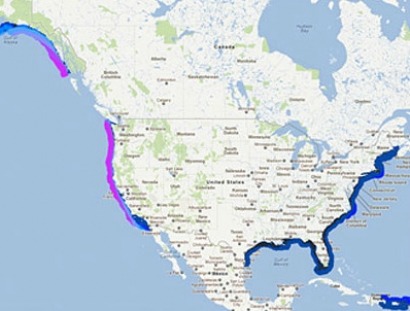
“These new wave and tidal resource assessments, combined with on-going analyses of the technologies and other resource assessments, show that water power, including conventional hydropower and wave, tidal, and other water power resources, can potentially provide 15% of our nation's electricity by 2030,” says the DOE's Office of Energy Efficiency and Renewable Energy.
Yesterday’s reports represent the most rigorous analysis undertaken to date to accurately define the magnitude and location of America's ocean energy resources. The information in these resource assessments can help to further develop the country's significant ocean energy resources, create new industries and new jobs in America, and secure US leadership in an emerging global market.
The United States uses about 4,000 terawatt hours (TWh) of electricity per year. DOE estimates that the maximum theoretical electric generation that could be produced from waves and tidal currents is approximately 1,420 TWh per year, approximately one-third of the nation's total annual electricity usage. Although not all of the resource potential identified in these assessments can realistically be developed, the results still represent major opportunities for new water power development in the United States, highlighting specific opportunities to expand on the 6% of the nation's electricity already generated from renewable hydropower resources.
The two reports—"Mapping and Assessment of the United States Ocean Wave Energy ResourcePDF" and "Assessment of Energy Production Potential from Tidal Streams in the United StatesPDF"—calculate the maximum kinetic energy available from waves and tides off US coasts that could be used for future energy production, and which represent largely untapped opportunities for renewable energy development in the United States.
West coast greatest wave resource
The West Coast, including Alaska and Hawaii, has especially high potential for wave energy development, while significant opportunities for wave energy also exist along the East Coast. Additionally, parts of both the West and East Coasts have strong tides that could be tapped to produce energy.
Earlier this year, DOE announced the availability of its national tidal resource database, which maps the maximum theoretically available energy in the nation's tidal streams. This database contributed to the "Assessment of Energy Production Potential from Tidal Streams in the United StatesPDF" report, prepared by Georgia Tech.
The wave energy assessment report, titled "Mapping and Assessment of the United States Ocean Wave Energy ResourcePDF," was prepared by the Electric Power Research Institute (EPRI), with support and data validation from researchers at Virginia Tech and DOE's National Renewable Energy Laboratory (NREL). The report describes the methods used to produce geospatial data and to map the average annual and monthly significant wave height, wave energy period, mean direction, and wave power density in the coastal United States. NREL incorporated the data into a new marine and hydrokinetic energy section in their US Renewable Resource atlas.
In addition to the wave and tidal resource assessments released yesterday, DOE plans to release additional resource assessments for ocean current, ocean thermal gradients, and new hydropower resources in 2012. To support the development of technologies that can tap into these vast water power resources, DOE's Water Power Program is undertaking a detailed technical and economic assessment of a wide range of water power technologies in order to more accurately predict the opportunities and costs of developing and deploying these innovative technologies. The Program is currently sponsoring over 40 demonstration projects that will advance the commercial readiness of these systems, provide first-of-a-kind, in-water performance data that will validate cost-of-energy predictions, and identify pathways for large cost reductions.
These resource assessments, techno-economic assessments, and technology demonstration projects are critical elements of DOE's strategy to capture the very real opportunities associated with water power development, and to further define the path to supplying 15% of the nation's electricity through water power technologies.
For additional information:

